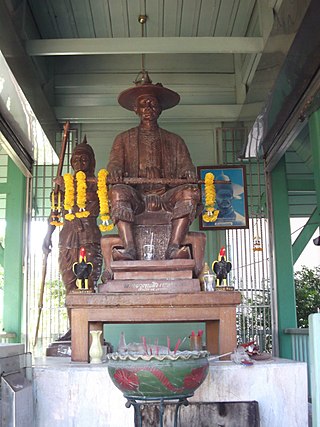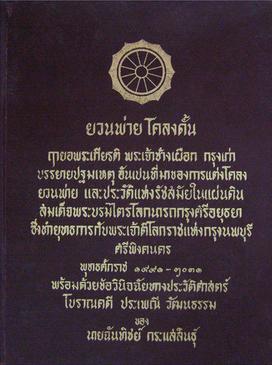
Phra Nakhon Si Ayutthaya, or locally and simply Ayutthaya, is one of the central provinces (changwat) of Thailand. Neighboring provinces are Ang Thong, Lopburi, Saraburi, Pathum Thani, Nonthaburi, Nakhon Pathom and Suphan Buri.

Ayutthaya Historical Park covers the ruins of the old city of Ayutthaya, Phra Nakhon Si Ayutthaya Province, Thailand. The city of Ayutthaya was founded by King Ramathibodi I in 1351,[a] though it is likely to be significantly older, based on evidence showing that the area was already populated during the Mon Dvaravati period. Sources further mention that around 850 AD, the Khmers occupied the area and established a stronghold there, naming it Ayodhya, after one of the holiest Hindu cities in India of the same name. The early history of Ayutthaya is connected to this Khmer settlement. Additionally, Prince Damrong has also attested to the existence of a city named Ayodhya, founded by the Khmers ruling from Lopburi at the point where the three rivers meet. An excavation map shows traces of an ancient baray close to the southwestern tip of Wat Yai Chai Mongkhon, which could have been built on a former important Khmer temple complex.

Thai literature is the literature of the Thai people, almost exclusively written in the Thai language. Most of imaginative literary works in Thai, before the 19th century, were composed in poetry. Prose was reserved for historical records, chronicles, and legal documents. Consequently, the poetical forms in the Thai language are both numerous and highly developed. The corpus of Thailand's pre-modern poetic works is large. Thus, although many literary works were lost with the sack of Ayutthaya in 1767, Thailand still possesses a large number of epic poems or long poetic tales —some with original stories and some with stories drawn from foreign sources. There is thus a sharp contrast between the Thai literary tradition and that of other East Asian literary traditions, such as Chinese and Japanese, where long poetic tales are rare and epic poems are almost non-existent. The Thai classical literature exerted a considerable influence on the literature of neighboring countries in mainland Southeast Asia, especially Cambodia and Burma.

Phetracha was a king of the Ayutthaya Kingdom, usurping the throne from his predecessor King Narai and originally settled in Phluluang Village. His dynasty, the Ban Phlu Luang dynasty, was the last ruling house of the Ayutthaya Kingdom.

Khun Chang Khun Phaen is a long Thai epic poem which originated from a legend of Thai folklore and is one of the most notable works in Thai literature. The work's entire length is over 20,000 couplets. Khun Chang and Khun Phaen are the leading male characters, where "Khun" was a junior feudal title given for male commoners. The story recounts the adventurous and amorous struggles of the three main protagonists. Much of their relationship can be described as a love triangle. Khun Phaen and Khun Chang compete for the lovely Wanthong from childhood for over fifty years. Their stories transpire amid the larger backdrop of national events, including two wars, several abductions, a suspected revolt, an idyllic sojourn in the forest, two court cases, trial by ordeal, jail, and treachery. Ultimately the King of Ayutthaya condemns Wanthong to death for failing to choose between the two men.

King Sanphet VIII or King Suriyenthrathibodi was the King of Ayutthaya from 1703 to 1708 and the second ruler of the Ban Phlu Luang Dynasty. Suriyenthrathibodi was also known by the noble title he held before ascending the throne, Luang Sorasak. He was the adopted son of Phetracha, the founder of the Ban Phlu Luang dynasty.

Maha Thammaracha, Maha Thammarachathirat, or Sanphet I, formerly known as Khun Phirenthorathep, was a king of Ayutthaya Kingdom from the Sukhothai dynasty, ruling from 1569 to 1590. As a powerful Sukhothai noble, Phirenthorathep gradually rose to power. After playing many political turns, he was eventually crowned as the King of Siam.

Ratsadathirat was the twelfth king of Ayutthaya, an ancient kingdom in Thailand. He was a son of Borommarachathirat IV and succeeded his father to the throne of Ayutthaya at the age of five in 895 LE. The following year, after having been on the throne for five months, he was put to death by his relative, Chairachathirat, who then assumed the kingship.

King Thong Lan was a king of Ayutthaya, an ancient kingdom in Thailand.
Ramrachathirat was a king of Ayutthaya, an ancient kingdom in Thailand.

Khanom krok or coconut-rice pancakes or mortar toasted pastry, is a traditional Thai dessert. They are prepared by mixing rice flour, sugar, and coconut milk to form a dough. Usually, khanom krok is composed of two batters, one salty and one sweet, both of which are cooked in a heating mantle—a hot indented frying pan. After heating, khanom krok is picked out of the mantle and the two half-circular doughs formed into a circular shape.

Yuan Phai, "Defeat of the Yuan," is a historical epic poem in the Thai language about rivalry between Ayutthaya and Lanna culminating in a battle that took place in 1474/5 AD at the place then called Chiang Cheun at Si Satchanalai. The Yuan are the people of Lanna or Yonok, then an independent kingdom in the upper reaches of the Chao Phraya River basin with a capital at Chiang Mai. The poem was written to celebrate King Boromma Trailokanat of Ayutthaya, the victor. The poem was probably written soon after the battle. It counts among only a handful of works of Thai literature from the Early Ayutthaya era that have survived, and may be still in its original form, without later revisions. The main body of the poem consists of 1,180 lines in a variant of the khlong meter. The poem is considered important as a source of historical information, as an example of poetic form and style, and as a repository of early Ayutthayan Thai language. A definitive edition was published by the Royal Institute of Thailand in 2001.

Wat Mahathat is a Buddhist temple in Ayutthaya, Thailand.

Si Prat is a legendary Thai poet believed to have served King Narai during the 17th century. According to traditional tellings, he was subsequently banished to South Thailand as a result of his personal indiscretions and executed after having an affair with the wife of a provincial governor.
The Testimonies of Ayutthaya are a group of historical documents derived from an original Mon chronicle compiled following the fall of Ayutthaya in 1767. While the original Mon copy has been lost, it has been translated into several versions in Burmese, Thai and English. The Thai versions were published as Khamhaikan Khun Luang Ha Wat and Khamhaikan Chao Krung Kao. A third document, Khamhaikan Khun Luang Wat Pradu Songtham is similarly titled and often grouped together as part of the Testimonies, although it has different origins.
Eulogy of King Narai is a poem in Thai, composed during the reign of King Narai (1656–1688). It is a major example of the Thai genre of royal panegyrics. The identity of the author is uncertain. The poem relates the key events of the reign, the king’s power, his palace at Lopburi, the beauties of the forest, and an elephant hunt.
Eulogy of King Prasat Thong is a long poem in Thai, composed during the king’s reign (1629–1656) by a senior noble. It is the first Thai poem which is specifically a royal panegyric and titled as such. It recounts the main events of the reign, including the building and renaming of the Chakkawat Phaichaiyon audience hall, adjustment of the calendar, a grand almsgiving, and a military parade and festival, all also described in the Royal Chronicles of Ayutthaya. It also states that King Prasat Thong is a bodhisatta, destined to become the tenth in a sequence of ten future Buddhas beginning with Metteyya. This claim is currently found in no other document. The sole manuscript, which was discovered in the 1980s, was copied in 1747/8 and is clearly incomplete. An annotated edition, including a facsimile of the original, was prepared by Buntuean Siworaphot and published in 2000.
Chaophraya Phrakhlang, personal name Hon, was the Phrakhlang or Siamese Minister of Trade from 1782 to 1805. He was also a prominent Thai author.
Chaophraya Phitsanulok, personal name Rueang or Boonrueang, was governor of Phitsanulok city with the noble title Chaophraya Surasi Bisanuvadhiraj, from 1732 to 1767. He was governor during the reign of King Borommakot, until the fall of the Ayutthaya Kingdom during the reign of King Ekkathat. In 1768, he proclaimed himself King Rueang of Phitsanulok, and declared Phitsanulok and part of Nakhon Sawan a new independent stat. or Prince Rueang, the King of Siam. His descendants were bestowed the Thai noble surname Rochanakul, a patronymic from Rueang’s family, by King Rama VI.

Miss Grand Phra Nakhon Si Ayutthaya is a Thai provincial beauty pageant which selects a representative from Phra Nakhon Si Ayutthaya province to the Miss Grand Thailand national competition. It was founded in 2016 by an entrepreneur Thippawee Suphanakorn.













